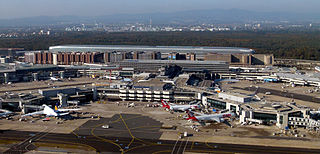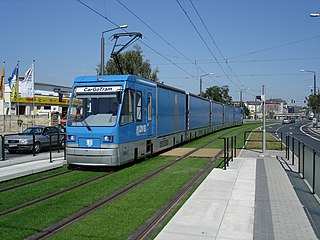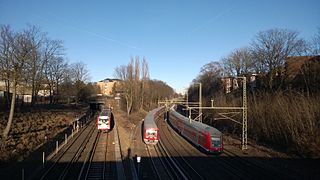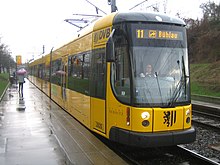
As a densely populated country in a central location in Europe and with a developed economy, Germany has a dense transport infrastructure.

Dresden is the capital city of the German state of Saxony and its second most populous city after Leipzig. It is the 12th most populous city of Germany, the fourth largest by area, and the third most populous city in the area of former East Germany, after Berlin and Leipzig. Dresden's urban area comprises the towns of Freital, Pirna, Radebeul, Meissen, Coswig, Radeberg and Heidenau and has around 790,000 inhabitants. The Dresden metropolitan area has approximately 1.34 million inhabitants.

Dresden Airport is the international airport of Dresden, the state capital of Saxony, Germany. It is located in Klotzsche, a district of Dresden 9 km (5.6 mi) north of the city centre. It was formerly also known in German as Flughafen Dresden-Klotzsche. Destinations from the airport include a few European cities and several holiday destinations.

Night service, sometimes also known as owl service, is a mode of public transport service operated during the night hours. As an intermediate approach – between providing full service around the clock and stopping services altogether – it provides more limited service during times of lower passenger volume, saving resources and allowing for maintenance on primary transportation systems. They typically offer fewer routes and less frequent service. Night-based services may be differently branded compared to daytime services. Examples are London and Chicago, where overnight buses are prefixed with an "N" for "night". Another common way to distinguish night services from their daytime counterparts is dark-colored line numbers. Some cities apply a different fare structure for night services from their daytime services.

The Dresden Funicular Railway is a funicular in Dresden, Germany, connecting the districts of Loschwitz, near the "Blue Wonder" bridge, and Weisser Hirsch.

The CarGoTram was a freight tram in Dresden, Germany that operated between 2001 and 2020. It supplied Volkswagen's "Transparent Factory" with parts for car assembly.

Dresden Hauptbahnhof is the largest passenger station in the Saxon capital of Dresden. In 1898, it replaced the Böhmischen Bahnhof of the former Saxon-Bohemian State Railway, and was designed with its formal layout as the central station of the city. The combination of a station building on an island between the tracks and a terminal station on two different levels is unique. The building is notable for its train-sheds, which are roofed with Teflon-coated glass fibre membranes. This translucent roof design, installed during the comprehensive restoration of the station at the beginning of the 21st century, allows more daylight to reach the concourses than was previously possible.

The Karlsruhe Stadtbahn is a German tram-train system combining tram lines in the city of Karlsruhe with railway lines in the surrounding countryside, serving the entire region of the middle upper Rhine valley and creating connections to neighbouring regions. The Stadtbahn combines an efficient urban railway in the city with an S-Bahn, overcoming the boundary between trams and trains. Its logo does not include the green and white S-Bahn symbol used in other German suburban rail systems and the symbol is only used at stops and stations outside the inner-city tram-operation area.

Dresdner Verkehrsbetriebe AG (DVB) is the municipal transport company of the city of Dresden in Germany. It is a member of the Verkehrsverbund Oberelbe transport association that manages a common public transport structure for Dresden and its surrounding areas. The DVB operates the Dresden tram network comprising 12 tram lines, with a total line length of approximately 210 kilometres (130.5 mi) and a total route length of 132.7 kilometres (82.5 mi), and 28 bus lines, with a total line length of approximately 306 kilometres (190.1 mi). It is also responsible for two funicular railways and three ferries across the River Elbe.

Rapid transit in Germany consists of four U-Bahn systems and fourteen S-Bahn systems. The U-Bahn commonly understood to stand for Untergrundbahn are conventional rapid transit systems that run mostly underground, while the S-Bahn or Stadtschnellbahn are commuter rail services, that may run underground in the city center and have metro-like characteristics in Munich, Hamburg and Berlin which they only have to a lesser extent in other cities. There are also over a dozen premetro or Stadtbahn systems that are rapid transit in the city center and light rail outside.

Berlin has developed a highly complex transportation infrastructure providing very diverse modes of urban mobility. 979 bridges cross 197 kilometers of innercity waterways, 5,334 kilometres (3,314 mi) of roads run through Berlin, of which 73 kilometres (45 mi) are motorways. Long-distance rail lines connect Berlin with all of the major cities of Germany and with many cities in neighboring European countries. Regional rail lines provide access to the surrounding regions of Brandenburg and to the Baltic Sea.

The Verkehrsverbund Oberelbe is a transport association run by public transport providers in the Saxon Elbeland area of the German state of Saxony. The VVO area comprises the city of Dresden, together with the districts of Meißen and Sächsische Schweiz-Osterzgebirge, and the north-western part of the district of Bautzen.

The Dresden tramway network is a network of tramways forming the backbone of the public transport system in Dresden, a city in the federal state of Saxony, Germany. Opened in 1872, it has been operated since 1993 by Dresdner Verkehrsbetriebe (DVB), and is integrated in the Verkehrsverbund Oberelbe (VVO).
Transport in Hamburg comprises an extensive, rail system, subway system, airports and maritime services for the more than 1.8 million inhabitants of the city of Hamburg and 5.3 million people in the Hamburg Metropolitan Region.

The Graz tramway network is a network of tramways forming an important part of the public transport system in Graz, which is both the capital city of the federal state of Styria, Austria, and the second largest city in Austria.

The Zürich trolleybus system is part of the public transport network of Zürich, Switzerland. Opened in 1939, it combines the Zürich S-Bahn, the Zürich tramway network and Zürich's urban motorbus network to form an integrated all-four style scheme.

The Erfurt Stadtbahn is a light rail network that is the basic public transit system of Erfurt, the capital of Thuringia in Germany. It represents the evolution of the city's original tramway which, outside of the city center, travels on track in its own right-of-way. The meter gauge network is made up of six lines, and has a total route length of 45.2 kilometers (28.1 mi), making it one of Germany's more moderate-sized Stadtbahn networks. The network is run by Stadtwerken Erfurter Verkehrsbetriebe AG, and is integrated in the Verkehrsverbund Mittelthüringen (VMT). The Stadtbahn carried 41.933 million passengers in 2012, which corresponds to about 114,885 passengers per day.
The Schöna / Bad Schandau / Pirna–Meißen railway is a two-track, electrified mainline railway in the German state of Saxony, predominantly served by the Dresden S-Bahn. It runs parallel to the pre-existing tracks of the Děčín–Dresden and Dresden–Leipzig railways. The section between Pirna and Dresden-Neustadt has been operated since 2004, afterwards the further sections from Dresden-Neustadt to Coswig have been upgraded. The Radebeul Ost–Coswig section was completed in 2013 and the section from Dresden-Neustadt to Radebeul Ost was completed in March 2016.

Dresden-Strehlen is a railway station located in the district of Strehlen in Dresden. Opening in 1903, the station serves Dresden S-Bahn and DB Regio Südost trains along with public transport from Dresdner Verkehrsbetriebe (DVB).

The Postplatz is a central square in Dresden and an important traffic junction, especially for local public transport. It is located in the old town not far from the Zwinger.

























